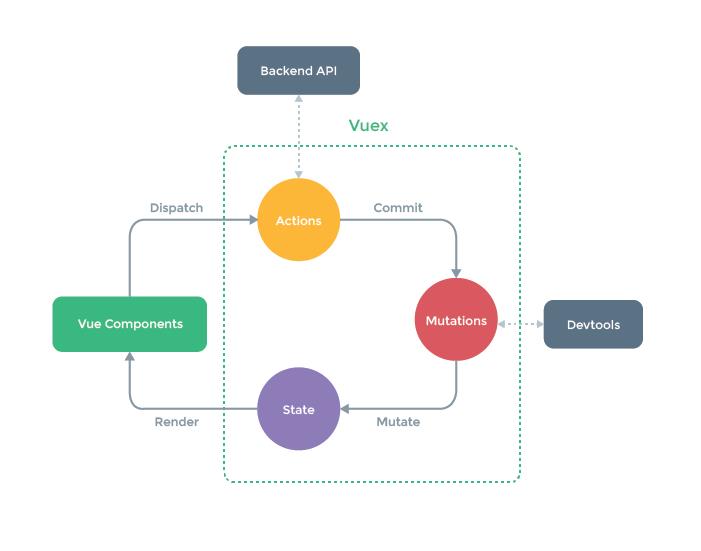概述及使用场景
Vuex 是一个主要应用在中大型单页应用的类似于 Flux 的数据管理架构。它主要帮我们更好地组织代码,以及把应用内的的状态保持在可维护、可理解的状态。
但如果是简单的应用 ,就没有必要使用vuex来管理状态了, 只会增加应用的复杂性 ,一个简单的应用完全可以使用$emit这种方式就可以来解决https://cn.vuejs.org/v2/guide/components.html#非父子组件的通信。 比如 ,通过父组件传值给子组件,子组件处理完数据,
如果需要对该属性值进行变更,则再发送给父组件就可以了,不需要使用vuex,
但是如果是大型项目中的公共属性,多个不关联的组件之间都需要使用某个属性,
如果这时候再使用传值就特别的不方便,逻辑很混乱,这时候放到vuex仓库就很简单了,
某组件对vuex的属性更改完了,其他任何组件都可以拿来用
用一张图来理解

以上是官方提供的一张状态管理图,从图中可以看出以下几点:
1、整个过程它是一个单向的数据流
2、涉及到几个核心概念Actions,mutations和state
3、组件可以调用actions,通过action来分发mutations ,只有 mutations 可以修改状态,store(仓库) 是响应式的,即状态的变化会在组件内部得到反映
另外,每一个 Vuex 应用的核心就是 store(仓库),包含着你的应用中大部分的状态 (state),他和单纯的全局对象不同的是:
1、Vuex 的状态存储是响应式的,当 Vue 组件从 store 中读取状态的时候,若 store 中的状态发生变化,那么相应的组件也会相应地得到高效更新
2、不能直接改变 store 中的状态,改变 store 中的状态的唯一途径就是显式地提交 (commit) mutation
vuex核心概念
state单一状态树
组件中获取状态,在计算属性中返回某个状态,例如
// 创建一个 Counter 组件
const Counter = {
template: `<div>{{ count }}</div>`,
computed: {
count () {
return store.state.count
}
}
}
当 store.state.count 变化的时候, 都会重新求取计算属性,并且触发更新相关联的 DOM
以上模式组件依赖全局状态单例,需要在每个使用 state 的组件中需要频繁地导入,vuex提供了一种机制将状态从根组件“注入”到每一个子组件中,通过在根实例中注册 store 选项,该 store 实例会注入到根组件下的所有子组件中,在子组件中就可以通过this.$store形式访问到
const app = new Vue({
el: \'#app\',
// 把 store 对象提供给 “store” 选项,这可以把 store 的实例注入所有的子组件
store,
components: { Counter },
template: `
<div class="app">
<counter></counter>
</div>
`
})
当一个组件需要获取多个状态时候,将这些状态都声明为计算属性会有些重复和冗余,这时候可以使用 mapState辅助函数帮助我们生成计算属性
1、通过import先把mapState 导入进来
import { mapState } from \'vuex\'
2、使用mapState
computed: mapState({
// 箭头函数可使代码更简练
count: state => state.count,
// 传字符串参数 \'count\' 等同于 `state => state.count`
countAlias: \'count\',
// 为了能够使用 `this` 获取局部状态,必须使用常规函数
countPlusLocalState (state) {
return state.count + this.localCount
}
})
当计算属性的名称与 state 的子节点名称相同时,也可以给 mapState 传一个字符串数组
computed: mapState([
// 映射 this.count 为 store.state.count
\'count\'
])
通过对象展开运算符可以使用...mapState形式简化写法
computed: {
localComputed () { /* ... */ },
// 使用对象展开运算符将此对象混入到外部对象中
...mapState({
// ...
})
}
getters,从 store 中的 state 中派生出一些状态
有时候我们需要从 store 中的 state 中派生出一些状态,例如过滤某个数组,可以在组件中的计算属性中获取到state然后过滤,但如果我们要在多个组件中去使用它,这样做法不太理想,这时我们可以在store中定义一个getters
const store = new Vuex.Store({
state: {
todos: [
{ id: 1, text: \'...\', done: true }
]
},
getters: {
doneTodos: state => {
return state.todos.filter(todo => todo.done)
}
}
})
组件中使用getters
computed: {
doneTodosCount () {
return this.$store.getters.doneTodos
}
}
使用mapGetters 辅助函数将 store 中的 getter 映射到局部计算属性
import { mapGetters } from \'vuex\'
export default {
// ...
computed: {
// 使用对象展开运算符将 getter 混入 computed 对象中
...mapGetters([
\'doneTodosCount\',
\'anotherGetter\',
// ...
])
}
}
mutation提交,更改store状态
更改 Vuex 的 store 中的状态的唯一方法是提交 mutation,每个 mutation 都有一个字符串的 事件类型 (type) 和 一个 回调函数 (handler),Vuex 中的 mutation 非常类似于事件
const store = new Vuex.Store({
state: {
count: 1
},
mutations: {
increment (state) {
// 变更状态
state.count++
}
}
})
如果要调用increment函数时,要唤醒一个 mutation handler,需要以相应的 type 调用 store.commit 方法
store.commit(\'increment\')
也可以向 store.commit 传入额外的参数
mutations: {
increment (state, n) {
state.count += n
}
}
store.commit(\'increment\', 10)
这里的参数也可以是一个对象
store.commit(\'increment\', {
amount: 10
})
使用常量替代 mutation 事件类型,这在多人协作的大型项目中,很有帮助,当然也可以不使用,看情况。
// mutation-types.js
export const SOME_MUTATION = \'SOME_MUTATION\'
// store.js
import Vuex from \'vuex\'
import { SOME_MUTATION } from \'./mutation-types\'
const store = new Vuex.Store({
state: { ... },
mutations: {
// 我们可以使用 ES2015 风格的计算属性命名功能来使用一个常量作为函数名
[SOME_MUTATION] (state) {
// mutate state
}
}
})
在组件中使用 this.$store.commit(\'xxx\') 提交 mutation,也可以使用 mapMutations 辅助函数将组件中的 methods 映射为 store.commit 调用(需要在根节点注入 store)
import { mapMutations } from \'vuex\'
export default {
// ...
methods: {
...mapMutations([
\'increment\', // 将 `this.increment()` 映射为 `this.$store.commit(\'increment\')`
// `mapMutations` 也支持载荷:
\'incrementBy\' // 将 `this.incrementBy(amount)` 映射为 `this.$store.commit(\'incrementBy\', amount)`
]),
...mapMutations({
add: \'increment\' // 将 `this.add()` 映射为 `this.$store.commit(\'increment\')`
})
}
}
使用Action可以使得在mutation中更方便的使用异步
在 Vuex 中,mutation 都是同步事务,Action 类似于 mutation,但不同的是Action 提交的是 mutation,而不是直接变更状态,并且可以包含任意异步操作
1、注册action
const store = new Vuex.Store({
state: {
count: 0
},
mutations: {
increment (state) {
state.count++
}
},
actions: {
increment (context) {
context.commit(\'increment\')
}
}
})
在我们需要调用 commit 很多次的时候,使用ES2015 的 参数解构 来简化代码
actions: {
increment ({ commit }) {
commit(\'increment\')
}
}
2、分发action
Action 通过 store.dispatch 方法触发:
store.dispatch(\'increment\')
看上去有点多此一举,为何不直接分发mutation,这是因为 mutation 必须同步执行,而我们可以在 action 内部执行异步操作
actions: {
incrementAsync ({ commit }) {
setTimeout(() => {
commit(\'increment\')
}, 1000)
}
}
同样,也可以使用载荷方式和对象方式进行分发
// 以载荷形式分发
store.dispatch(\'incrementAsync\', {
amount: 10
})
// 以对象形式分发
store.dispatch({
type: \'incrementAsync\',
amount: 10
})
3、在组件中分发action
在组件中使用 this.$store.dispatch(\'xxx\') 分发 action,或者使用 mapActions 辅助函数将组件的 methods 映射为 store.dispatch 调用
import { mapActions } from \'vuex\'
export default {
// ...
methods: {
...mapActions([
\'increment\', // 将 `this.increment()` 映射为 `this.$store.dispatch(\'increment\')`
// `mapActions` 也支持载荷:
\'incrementBy\' // 将 `this.incrementBy(amount)` 映射为 `this.$store.dispatch(\'incrementBy\', amount)`
]),
...mapActions({
add: \'increment\' // 将 `this.add()` 映射为 `this.$store.dispatch(\'increment\')`
})
}
}
module,将 store 分割成模块
由于使用单一状态树,应用的所有状态会集中到一个比较大的对象。当应用变得非常复杂时,store 对象就有可能变得相当臃肿。
为了解决以上问题,Vuex 允许我们将 store 分割成模块(module)。每个模块拥有自己的 state、mutation、action、getter
const moduleA = {
state: { ... },
mutations: { ... },
actions: { ... },
getters: { ... }
}
const moduleB = {
state: { ... },
mutations: { ... },
actions: { ... }
}
const store = new Vuex.Store({
modules: {
a: moduleA,
b: moduleB
}
})
store.state.a // -> moduleA 的状态
store.state.b // -> moduleB 的状态
vuex调试工具
https://github.com/vuejs/vue-devtools
相关文章
用 Vuex 构建一个笔记应用
https://segmentfault.com/a/1190000005015164
从一个改写后的vue小应用认识vuex
https://www.jianshu.com/p/9dcbe1fec24d
作者:fozero
声明:原创文章,转载请注明出处,谢谢!http://www.cnblogs.com/fozero/p/8094265.html
标签:vuejs,vuex,前端